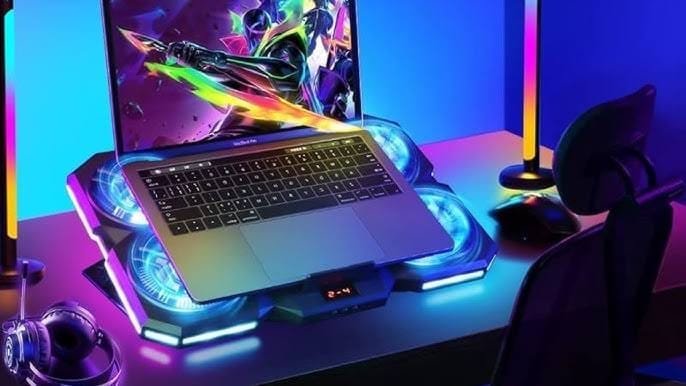Laptop overheating is a frustrating issue that can lead to performance slowdowns, system crashes, and even long-term damage. While intense usage and demanding applications can contribute to heat buildup, often the culprit is simply a buildup of dust and debris within your laptop’s delicate cooling system. Fortunately, you can take proactive steps to clean your laptop and keep it running cool.
This guide will walk you through the process, covering everything from basic external cleaning your laptop to more involved internal cleaning.
Why Does Your Laptop Overheat?
Before exploring the steps to cleaning your laptop, it’s crucial to understand why laptops overheat. The primary culprit is the internal cooling system, which consists of:
- Heat Sink: A metal component designed to draw heat away from the processor (CPU) and graphics processing unit (GPU).
- Heat Pipes: Small tubes filled with a cooling liquid that transfer heat from the heat sink to the fan.
- Fan: The component that blows hot air away from the heat sink and out of the laptop.
- Ventilation: Grilles and openings on the laptop’s chassis that allow for airflow.
When these components become clogged with dust, pet hair, and other debris, their efficiency drastically reduces. Heat accumulates, and the laptop struggles to dissipate it, leading to overheating. Other factors can also contribute to overheating, such as:
- Demanding Applications: Running graphics-intensive games or editing software can push your CPU and GPU to their limits, generating significant heat.
- Poor Ventilation: Placing your laptop on a soft surface like a bed or blanket can block the intake vents, preventing proper airflow.
- Ambient Temperature: Using your laptop in a hot environment can exacerbate the problem.
- Internal Thermal Paste Deterioration: The thermal paste between the CPU/GPU and the heat sink can dry out over time, reducing heat transfer efficiency (this is advanced maintenance and will be discussed later).
Read More: Understanding Laptop Specifications: What Do You Really Need?
Step-by-Step Guide to Cleaning Your Laptop
This guide will break down the process into external and internal cleaning, starting with the easiest and moving towards more complex procedures.
Part 1: External Cleaning – The First Line of Defense
Externally cleaning your laptop is a routine cleaning you should perform regularly (ideally every couple of weeks) to prevent significant dust buildup.
What You’ll Need:
- Soft, lint-free cloths (microfiber cloths are ideal)
- Isopropyl alcohol (70% or higher)
- Distilled water (optional)
- Cotton swabs
- Compressed air (canned air)
Steps:
- Power Down and Unplug: Always start by shutting down your laptop completely and disconnecting the power adapter.
- Dampen Cloth (Optional): Lightly dampen a soft cloth with isopropyl alcohol or distilled water. Avoid soaking the cloth.
- Wipe Down the Exterior: Carefully wipe the entire exterior of your laptop, including the lid, base, keyboard, and trackpad. Pay particular attention to areas where you touch the laptop frequently, as these areas accumulate oils and grime. Avoid getting any liquid inside the vents or openings.
- Clean the Screen: Use a separate, clean microfiber cloth to wipe the screen. If necessary, use a screen cleaner specifically designed for laptop displays. Avoid harsh chemicals.
- Clean the Keyboard: Use a dry cloth to wipe down the keyboard. For stubborn grime between the keys, lightly dampen a cotton swab with isopropyl alcohol. Be careful not to drip any liquid. You can also use compressed air to dislodge larger dust particles.
- Clean the Ports: Use compressed air to blow out any dust or debris from the USB ports, headphone jack, charging port, and any other openings. If needed, gently use a cotton swab dipped in isopropyl alcohol to clean the inside of these ports, ensuring they are completely dry before using.
- Clean External Vents: Use compressed air to blow out any dust from the external vents. Hold the compressed air upright and in short bursts. Be very careful not to tip the can or use it upside down as this can spray the liquid propellant inside onto your computer, which can damage it.
Part 2: Internal Cleaning – Tackling the Heart of the Issue
This process is more involved and requires a bit of technical know-how. If you’re uncomfortable disassembling your laptop, it may be best to seek professional help. Disclaimer: Disassembling your laptop could void the warranty, so proceed at your own risk.
Important Precautions Before Disassembly:
- Static Electricity: Work in an environment with low static electricity. Ground yourself by touching a grounded metal object before starting. Consider wearing an anti-static wrist strap.
- Take Pictures: Throughout the disassembly process, take pictures of each step. This will help you reassemble the laptop correctly.
- Consult your manual: Find a manual online that shows you all the components of your machine and guides you through the disassembly process.
- Organize Screws: Use a small container or a magnetic parts tray to keep track of screws and other small components.
- Gentle Handling: Be extremely gentle when handling internal components. Most pieces can be damaged with even a slight amount of force.
- Right tools: Ensure you have the correct Phillips-head, flathead or Torx screwdriver for your particular machine, along with a spudger, small paint brush, and thermal paste (if required).
Steps for Internal Cleaning (General Guide):
- Consult your laptop’s manual or a reliable YouTube tutorial specific to your model before starting to disassemble. Not all laptops are built alike.
- Prepare your workspace: Lay out a soft cloth or anti-static mat on a clean, flat surface.
- Remove the Back Panel: Using the appropriate screwdriver, carefully remove the screws holding the back panel in place. Remember to keep these screws organized. Use a spudger (a safe tool for prying open delicate electronic components) to gently and carefully pry open the back panel of the laptop. If the panel resists prying, it is probably because of more screws hidden somewhere on the machine. Ensure all screws have been removed before trying to force it open.
- Locate the Cooling System: Identify the heat sink, heat pipes, fan, and ventilation pathways. They will usually be grouped in a single area.
- Dust the Internal Components: Using compressed air in short bursts, carefully blow away dust and debris from the heat sink, fan blades, and ventilation pathways. You may also use a soft brush to loosen any stubborn dust.
- Clean the Fan: If possible, carefully remove the fan to clean it thoroughly. Use a soft brush to clean the fan blades. If they are particularly dirty, you can use a damp cloth with a small amount of isopropyl alcohol. Allow the fan to dry completely before reassembling.
- Clean the Heat Sink: The same cleaning methodology for the fan applies here. Do not remove the heatsink from the CPU unless you are comfortable with removing old thermal paste and replacing it with a new application.
- Reassembly: Carefully reassemble your laptop, following your photos and/or video tutorials. Ensure all screws are fully tightened but avoid over tightening.
- Test your Machine: Turn the laptop on to ensure that all components including the screen, keyboard and trackpad are working correctly. Check the system temperature by looking in your task manager or using a third-party program.
Advanced Considerations – Thermal Paste Application
If your laptop continues to overheat after cleaning, the thermal paste between the CPU/GPU and the heat sink might be dry and need replacement. This is a more advanced procedure and not recommended for beginners. It involves:
- Removing the Heat Sink: Carefully detach the heat sink from the CPU/GPU.
- Cleaning the Old Thermal Paste: Use isopropyl alcohol and a lint-free cloth to gently clean off the old thermal paste from both the CPU/GPU and the heat sink.
- Applying New Thermal Paste: Apply a small, pea-sized amount of new thermal paste to the center of the CPU/GPU.
- Reattaching the Heat Sink: Carefully reattach the heat sink, ensuring even pressure.
Preventing Overheating in the Future
Beyond cleaning your laptop, here are some tips to help prevent overheating:
- Use a Hard Surface: Avoid using your laptop on soft surfaces like blankets or pillows that can block the vents.
- Use a Laptop Stand: A laptop stand can improve airflow and cooling. Some stands even come with built-in fans.
- Monitor Usage: Avoid running too many demanding applications simultaneously.
- Keep Software Up-to-Date: Ensure your operating system, drivers, and applications are up to date. Software updates often include performance optimizations that can reduce heat output.
- Clean Regularly: Make external cleaning a routine and perform an internal clean every 6-12 months depending on frequency of use and how dusty your environment is.
- Consider Undervolting: For advanced users, underclocking or undervolting your CPU can significantly reduce heat output and improve battery life.
When to Seek Professional Help
If you’ve tried all these steps and your laptop still overheats, it’s time to seek professional help from a qualified technician. There might be underlying hardware issues that require expert diagnosis and repair.
Conclusion
Cleaning your laptop is an essential part of maintaining its performance and longevity. By following these steps and implementing preventative measures, you can keep your laptop running cool and prevent the frustration of overheating. Remember to be fast, take your time, and be gentle with your device. Regular maintenance is key to a healthy laptop that will serve you well for years to come.




